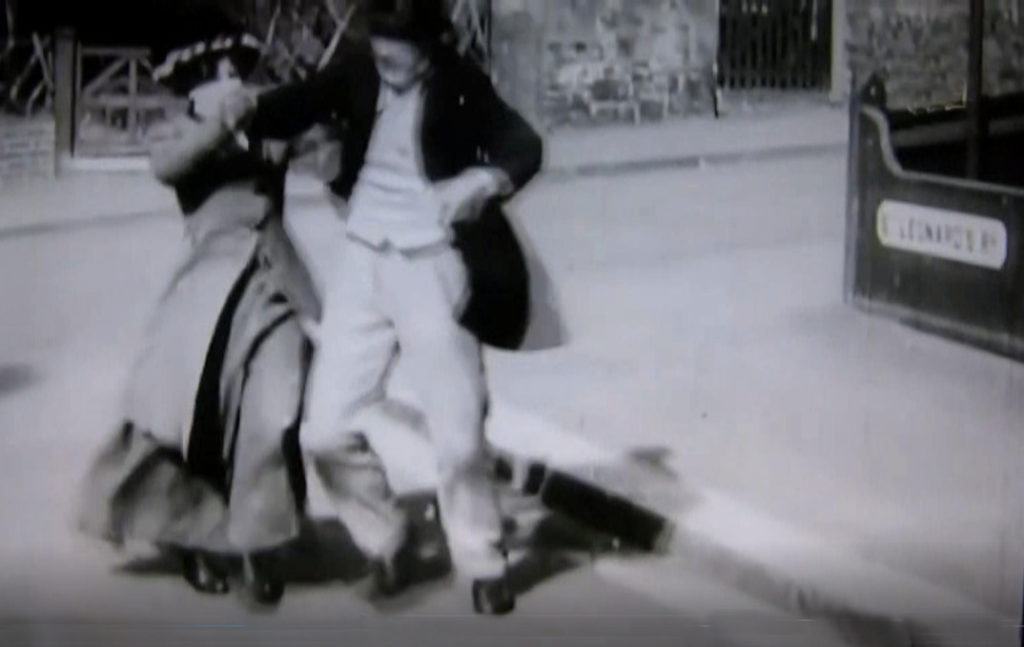A number of short silent films featuring jujutsu were produced and/or screened in London during the very early 20th century. The intriguing list of titles includes:
- HE LEARNED JU-JITSU – SO DID THE MISSUS (1905)
- JIU JITSU DOWNS THE FOOTPADS, OR, THE LADY ATHLETE (1907)
- CHARLEY SMILER TAKES UP JU-JITSU (1911)
- PIK NIK PROFESSORE DI JUJITSU (1911)
- THE ART OF JU-JITSU (documentary, 1912)
- JU-JITSU TO THE RESCUE (1913)
- SELF DEFENCE (1913)
- NOBBY’S JU-JITSU EXPERIMENTS (1914)
- ART OF SELF-DEFENCE BY JU-JITSU METHODS (1918)
Unfortunately, aside from their titles and scattered items of production information, these films have defied re-discovery other than The Art of Ju-jitsu documentary of 1912. It’s entirely possible that many of the others may have been lost forever. Recently, however, two major scenes from Charley Smiler Takes Up Ju-Jitsu were found as part of a 1950s-vintage TV compilation of early silent comedies, in which they had been edited together and re-titled Ju-Jitsu-Itus!
Little is known about the original film’s production except that it was directed by David Aylott as part of a series of slapstick comedy shorts starring Fred Evans as “Charley Smiler”. A contemporary and childhood friend of Charlie Chaplin’s, Evans was a highly popular performer during the early 1900s.
Charley Smiler Takes Up Ju-Jitsu was originally released on August 10th of 1911 and then re-released in 1915. Here’s a description of the plot, from The Bioscope of August 3, 1911:
Smiler is one of a number of people who gather outside a booth, inside which a troupe of wrestlers is performing. He is so impressed by the skill of the performers that he seizes a fellow member of the audience and tries to throw him, only himself to be roughly handled by one of the Japs, who pitches him out of the tent.
Smiler begins to practise on others the falls he has been so painfully acquainted with. A pair of lovers are given introduction to the art, and the man takes a flight over Smiler’s shoulder, as does a fisher, who finds himself pitched head first into the water. In a country farmer Smiler meets more than his match, and has such a rough time that he limps away with his liking for ju-jitsu all but cured, though a bout with a tailor’s dummy revives him a little, and he is still further exhilarated by the ease with which he topples over a long row of bobbies.
The next person he runs across, however, knows a little more about ju-jitsu than he does, and though she is only a slight girl, throws him over her shoulder with the greatest of ease.
Although only the opening and closing scenes were preserved in the 1950s compilation, by lucky chance those two scenes are most likely to be of significance to modern viewers with an interest in the early history of jujutsu in the Western world.
Here are the scenes:
At the time this film was produced there was only one full-time martial arts dojo operating in London – the Golden Square School of Jujitsu, which had been founded by former Bartitsu Club instructor Sadakazu Uyenishi in 1903, just about one year after the Bartitsu Club had closed down. Uyenishi himself had demonstrated his art in some film footage shot by the Gaumont Company in 1905 (you can see it reanimated here). When Uyenishi returned to Japan in 1907, management of the Golden Square School passed to his senior students, the husband and wife team of William and Edith Garrud.
Although it’s impossible to be certain, it’s at least likely that the various “stunt performers” featured in Charley Smiler Takes Up Ju-Jitsu were members of the Golden Square dojo. The two gi-clad “booth wrestlers” in the opening scene look like jujutsuka play-acting for the camera, rather than like slapstick actors imitating jujutsu. As a highly trained music hall tumbler, Smiler (Evans) himself was clearly capable of taking his own falls throughout the film.
Most intriguing, though, is the possibility that the jujitsuffragette “Miss U.I. Throwe”, who teaches Charley an object lesson at the end, may also have been a Garrud student, or may even have been played by Edith Garrud herself. She had started teaching a suffragettes-only self-defence club in 1909, and in 1913 she was famously recruited to train the clandestine WSPU Bodyguard; the team of security specialists who defended outlaw suffragettes from assault and arrest.

There are only a few clear photographs of Edith Garrud circa 1911 and the visual quality of the Charley Smiler film isn’t good enough to be able to positively identify “Miss Throwe”, but Edith would have been more than qualified to essay this role – not least because she had previously starred in Ju-jitsu Downs the Footpads, or, the Lady Athlete (1907) – and there is a definite resemblance. While “Miss Throwe” is clearly shorter than Evans, though, it may be that she’s taller than 4’11”, which was Edith Garrud’s reported height.
Regardless of who played “Miss U.I. Throwe”, the jujitsu footage in Charley Smiler is among the earliest known filmed representations of Japanese martial arts, the earliest known moving imagery of a woman demonstrating jujutsu by some 15 years and is literally the only film known to exist of “suffrajitsu” in action during the early 20th century.


